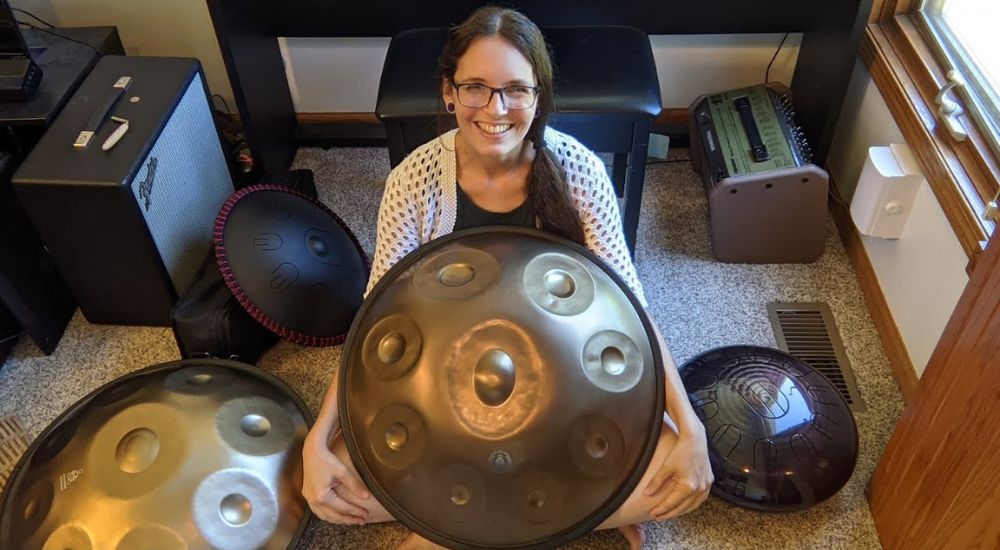In a world dominated by fast beats and digital rhythms, there’s something irresistibly soothing about the handpan and tongue drum. These steel instruments don’t just create sounds — they emit emotions. Their gentle, resonant tones have the power to calm the mind, inspire creativity, and transport listeners to a peaceful, meditative state. Whether you’re a music lover, a mindfulness enthusiast, or just someone craving serenity, these instruments offer a rare kind of beauty.
Understanding the Handpan
Born from a blend of steel drum tradition and innovative design, the handpan was first introduced in the early 2000s in Switzerland. It’s usually made of two half-shells of steel that are glued together, forming a UFO-like shape. Players use their hands to tap, brush, and strike the instrument, creating harmonious melodies and percussive rhythms simultaneously. Its surface has tuned notes arranged in a circle around a central tone, allowing for intuitive and expressive play. What makes it mesmerizing is its ability to combine melody and rhythm effortlessly.
Exploring the Tongue Drum
Tongue drums, on the other hand, are much older in concept and have evolved from slit drums made of wood. Modern tongue drums are often crafted from steel and have cut-out “tongues” in varying sizes that produce different notes when struck. You can play them with fingers or mallets, and they’re usually more affordable and compact than handpans. While handpans have a brighter, singing tone, tongue drums are known for their soft, bell-like quality that resonates deeply.
Sound Healing and Meditation
Both instruments have earned a sacred spot in sound therapy. Their rich overtones and sustained notes make them ideal for meditation, yoga, or emotional healing. Sound healers often use them in sessions to help reduce anxiety, release emotional blockages, and restore balance in the body’s energy field. The sound waves created are felt as much as they are heard, gently vibrating through the listener’s body and nervous system.
Choosing the Right Instrument
Selecting your first handpan or tongue drum isn’t just about looks. It’s about feel, sound, and purpose. Do you want something deeply meditative? Or a versatile tool for musical performance? Handpans often come in D minor or Celtic scales, while tongue drums offer everything from pentatonic to chromatic. Material matters too: stainless steel is more durable and resistant to rust, while nitrided steel offers a warm tone.
Learning to Play
You don’t need to be a musician to start. That’s the beauty of these instruments — they’re intuitive. Many people find themselves making music minutes after touching one. You can find online tutorials, guided courses, or simply explore freely. Handpans may require more finger coordination, whereas tongue drums are very beginner-friendly, especially when using mallets.
Maintenance and Care
To ensure your instrument stays beautiful and sounds great, clean it regularly with a soft cloth. Avoid moisture, and always store it in a protective case. For steel instruments, applying a small amount of protective oil can prevent rust. Never leave them in extreme heat or cold, as this could affect tuning or even crack the surface.
Where to Buy
While you can find both instruments online, it’s best to test them in person if possible. Reputable handpan makers include PANArt, Ayasa, and Yishama. For tongue drums, look for brands like Rav Vast, Idiopan, and Meinl. Always check reviews, tuning accuracy, and whether the seller offers sound samples before buying.
Community and Culture
A global community of players and builders continues to grow around these instruments. There are forums, Facebook groups, and even entire festivals dedicated to the handpan and tongue drum. These communities are welcoming, collaborative, and passionate — perfect for anyone looking to deepen their connection with sound and creativity.
DIY Handpans and Tongue Drums
Yes, people do make their own! Tongue drums, especially, are more accessible for DIY crafters using propane tanks or laser-cut steel. But handpans are a different beast. Their precise tuning and forming process require significant skill, special tools, and experience. Still, for those passionate about the process, it can be a rewarding project.
Professional Use in Music
Artists across genres are weaving handpan and tongue drum tones into their compositions. From world music and ambient to pop and electronic, these instruments bring a natural, organic layer to modern soundscapes. Musicians like Daniel Waples, Kabecao, and Hang Massive have brought these sounds to global stages and streaming platforms alike.
Emotional and Mental Health Benefits
Playing these instruments can be as healing as listening. They help regulate breathing, reduce stress, and even enhance focus — making them excellent tools for children, adults, and therapists alike. Their gentle tones engage the parasympathetic nervous system, which is responsible for rest and relaxation.
Comparing the Two Instruments
Can’t decide between a handpan and a tongue drum? Think of it like this: if the handpan is a grand piano, the tongue drum is a soothing music box. Handpans offer more dynamic range and expressive depth, while tongue drums are simpler, lighter, and more affordable. It really comes down to your goals and budget.
The Future of Handpans and Tongue Drums
As their popularity spreads, more makers, musicians, and educators are joining the scene. Innovations in material, tuning techniques, and accessibility are making these instruments more available than ever. And with rising interest in mindfulness and wellness, their future sounds bright — and beautifully resonant.
Conclusion
Handpans and tongue drums are more than instruments; they’re companions on a journey of emotional expression and inner calm. Whether you’re a curious beginner or a seasoned musician, these melodic steel wonders invite you to slow down, breathe deeply, and connect with the pure magic of sound. In a noisy world, their soft voices offer peace.







